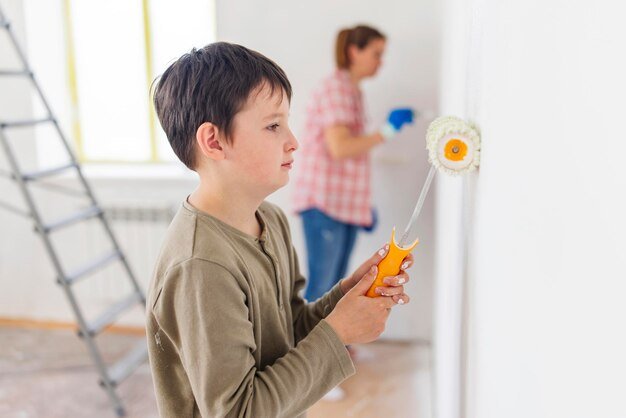When tackling a home painting project, one of the most common questions is: do I paint the trim or walls first? This decision can significantly impact the final look and efficiency of your work. If you’re aiming for crisp lines, a professional finish, and a smooth workflow, understanding the best order is crucial.
In this guide, we’ll cover:
- The pros and cons of painting trim first vs. walls first
- The best order to follow for a seamless painting process
- Essential tools and materials needed
- Step-by-step instructions for flawless results
- Pro tips to avoid common painting mistakes
Trim First or Walls First: Which Is Best?
Most professional painters recommend painting the trim first, then the walls. Why? Because trim requires more precise brushwork, and it’s easier to tape off and paint over mistakes when tackling walls afterward. However, there are situations where painting walls first may be preferable.
Let’s break down both methods.
Option 1: Painting Trim First
Pros:
✅ Easier to tape off trim later when painting walls
✅ Less risk of brush strokes showing on walls
✅ Allows for smoother edges and cleaner lines
✅ Drips and splatters on the wall can be covered when painting the walls later
Cons:
❌ Requires extra time to wait for trim to dry before taping it off
❌ More careful brushwork is needed around trim edges
Option 2: Painting Walls First
Pros:
✅ No risk of wall paint getting on freshly painted trim
✅ Faster process if walls require more coverage
✅ Ideal for textured walls where taping trim may be tricky
Cons:
❌ Risk of damaging wall paint when taping for trim
❌ Touch-ups may be needed due to trim paint splatters
❌ More challenging to achieve crisp lines
Best Order to Paint for a Professional Finish
If you want the most efficient and professional-looking results, follow this order:
Start with Prep Work
Before painting anything, proper preparation ensures a smooth and durable finish.
- Move furniture away or cover it with drop cloths.
- Clean walls and trim to remove dust and grease.
- Patch holes and sand rough surfaces.
- Tape off areas where trim meets the walls and ceilings.
- Paint the Trim First
Since trim requires precision, starting here is best. Use these steps:
- Apply primer (if necessary) for a long-lasting finish.
- Use high-quality trim paint (semi-gloss or gloss works best for durability).
- Apply the paint with a high-quality brush for smooth strokes.
- Allow trim to dry completely before taping it off to prevent peeling.
- Paint the Ceiling (If Applicable)
If your project includes the ceiling, tackle it next. Painting the ceiling first prevents unwanted drips on freshly painted walls or trim.
Tape Off the Trim and Paint the Walls
Once the trim is fully dry, tape it off and move on to the walls.
- Use a roller for large surfaces and a brush for corners.
- Apply at least two coats for full coverage.
- Cut in carefully around the edges with a brush for precise lines.
- Remove Tape and Touch Up
After everything has dried, remove the painter’s tape carefully. Inspect for any mistakes and touch up areas with a small brush.
Essential Tools and Materials for Painting Trim and Walls
For the best results, having the right tools is crucial: ✔️ High-quality paintbrushes (angled brush for trim)
✔️ Paint roller and extension pole
✔️ Painter’s tape
✔️ Drop cloths
✔️ Sandpaper
✔️ Caulk (for sealing gaps in trim)
✔️ Primer (if needed)
✔️ High-quality wall and trim paint
Pro Tips for a Perfect Paint Job
- Choose the right paint finish – Use semi-gloss or gloss for trim and satin or matte for walls.
- Use long, smooth strokes when painting trim to avoid visible brush marks.
- Don’t overload your brush or roller – Too much paint causes drips and uneven coverage.
- Work in sections to maintain a wet edge and prevent lap marks.
- Ventilate the room well to speed up drying time and reduce paint fumes.
FAQs: Do I Paint the Trim or Walls First?
What if I’m repainting a room? Should I still paint the trim first?
Yes, even when repainting, painting the trim first is generally the best approach for cleaner lines and fewer touch-ups.
Can I use the same paint for trim and walls?
No, trim paint is typically more durable and has a higher sheen. Walls usually require a different finish.
How long should I wait before taping off the trim?
Wait at least 24 hours to ensure it is fully dry before taping over it.
Final Thoughts: Do I Paint the Trim or Walls First?
If you’re still wondering, do I paint the trim or walls first? the best approach is to paint the trim first, then the walls. This method offers better control, neater lines, and a polished finish. While painting walls first may work in certain scenarios, the trim-first method remains the preferred choice for professional results.
By following this guide, you’ll achieve a stunning, long-lasting paint job with minimal hassle. Ready to start your project? Grab your brushes and get painting!

